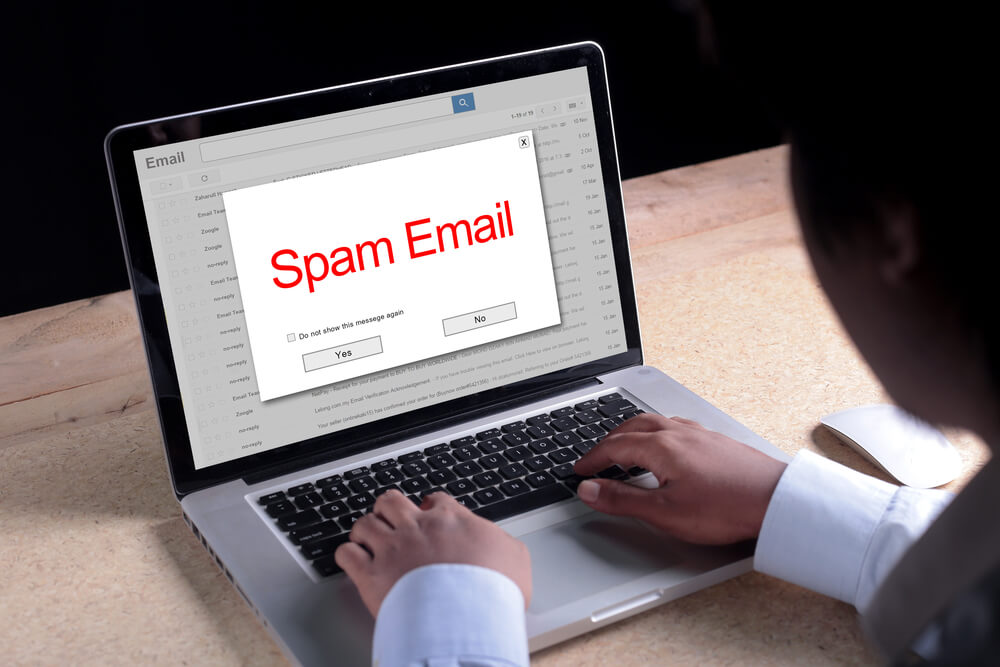
5 Best Practices Let B2B Email Marketers Bypass Spam Filters
You spent a lot of time crafting the perfect B2B marketing email … Wouldn’t it be a shame if the recipient never got to see it because it got caught by spam filters?
Email that gets sent to spam almost never gets read. Worse, the more your email gets caught by spam filters, the less reputable your domain looks. If this is not addressed, even the emails you send to your best and most loyal customers end up in spam.
Don’t let spam filters defeat your B2B email marketing campaign. Follow these tips from our expert marketers:
 As mentioned above, domains contain certain email protocols, including:
As mentioned above, domains contain certain email protocols, including:
 Now we get into the content. Make sure your subject line is clean, clear, and professional. Garbled or nonsensical text may raise red flags.
Recipients also see nonsensical headlines as red flags. If you confuse the recipient or arouse suspicion, they may hit you with the dreaded “Mark As Spam” button. Now your emails are permanently out of their inbox and your domain reputation suffers.
Edgy tactics may pique curiosity and get people to click, but they are risky. Only do that with domains that already have a good reputation and recipients who already have a history of receiving your emails.
Now we get into the content. Make sure your subject line is clean, clear, and professional. Garbled or nonsensical text may raise red flags.
Recipients also see nonsensical headlines as red flags. If you confuse the recipient or arouse suspicion, they may hit you with the dreaded “Mark As Spam” button. Now your emails are permanently out of their inbox and your domain reputation suffers.
Edgy tactics may pique curiosity and get people to click, but they are risky. Only do that with domains that already have a good reputation and recipients who already have a history of receiving your emails.
 The formatting of your email can make a big difference in its deliverability. Common recommendations for email formatting include:
The formatting of your email can make a big difference in its deliverability. Common recommendations for email formatting include:
- Understand how spam filters work
- Optimize your domain’s email protocols.
- Ask opt-ins to “whitelist” you.
- Craft a clear, professional subject line.
- Send from a recognizable sender name.
- Keep a clean, updated list.
- Send relevant, high-quality content.
- Optimize your email formatting.
- Include an “Unsubscribe” option.
- Monitor your domain’s email sending reputation.
Tired of investing in Search Engine Optimization without getting any results? See how Digital Authority Partners turns that around!
Understanding Spam Filters in Email Marketing
Every email client imposes some sort of automated digital filter to identify spam and keep it out of their users’ inboxes. A strong spam filter is a necessary part of digital life, but they are not perfect. Spam filters are not human beings. Instead, spam filters use artificial intelligence (AI) and machine learning (ML) to try and identify spam emails in fractions of a second while they are still in transit from the sender to the recipient. Spam filters work by analyzing the content, headers, and images. They check the reputation of the domain and the IP sending the emails, cross-referencing them against online public “blacklists” of known spammers. Finally, spam filters look at email protocols like Sender Policy Framework (SPF), DomainKeys Identified Mail (DKIM), and Domain-based Message Authentication, Reporting & Conformance (DMARC) to determine the authenticity of the email. If your emails start regularly getting filtered as spam, it can become a downward spiral. Email clients can detect if your emails have been identified as spam and will act on this information. Your domain may even get reported to a public blacklist. Other email clients will take note of this blacklisting, and start filtering your emails as spam. Before you know it, none of your emails are making it to inboxes. Recovering the reputation of a domain can be a long and arduous process, especially if the domain gets blacklisted. Many companies that suffer this fate find it easier to simply abandon their domain, or set up a dummy domain solely for marketing. If this is not an option for you, there are many things you can do to make sure that your emails end up where they belong — in the inbox. Here are 9 best practices for B2B email marketers to bypass spam filters.1. Optimize Your Domain Email Protocols
 As mentioned above, domains contain certain email protocols, including:
As mentioned above, domains contain certain email protocols, including:
- SPF (Sender Policy Framework)
- DKIM (DomainKeys Identified Mail)
- DMARC (Domain-based Message Authentication, Reporting & Conformance)
2. Ask Your Opt-ins to “Whitelist” You
When a prospect opts in to an email list, they usually get a “welcome” email, often with an attachment to the lead magnet deliverable (a free quote, PDF report, etc.) Include some text in this email asking the recipient to “whitelist” your email address. This is marketing shorthand to antithesize it from the blacklists that spammy domains get put on, but it’s actually a much simpler process. Whitelisting an email address just means that the user identifies the sender as a trusted sender, specifically asking their email client not to filter those emails. In the past, this meant the user adding your email address to their contacts database. Now many email clients are even simpler, adding a one-click whitelist option. Gmail, for example, has the “Mark As Not Spam” button on their interface. Considering the popularity of Gmail, it is definitely good practice to point out this feature and ask Gmail users to click that button for you. Not everyone will accept your invitation to whitelist your email, but every successful delivery counts. Just as spam filtration can be a downward spiral, high inbox rates can be an upward spiral, contributing to a good domain reputation.3. Craft a Clear and Professional Subject Line
 Now we get into the content. Make sure your subject line is clean, clear, and professional. Garbled or nonsensical text may raise red flags.
Recipients also see nonsensical headlines as red flags. If you confuse the recipient or arouse suspicion, they may hit you with the dreaded “Mark As Spam” button. Now your emails are permanently out of their inbox and your domain reputation suffers.
Edgy tactics may pique curiosity and get people to click, but they are risky. Only do that with domains that already have a good reputation and recipients who already have a history of receiving your emails.
Now we get into the content. Make sure your subject line is clean, clear, and professional. Garbled or nonsensical text may raise red flags.
Recipients also see nonsensical headlines as red flags. If you confuse the recipient or arouse suspicion, they may hit you with the dreaded “Mark As Spam” button. Now your emails are permanently out of their inbox and your domain reputation suffers.
Edgy tactics may pique curiosity and get people to click, but they are risky. Only do that with domains that already have a good reputation and recipients who already have a history of receiving your emails.
4. Use a Recognizable Sender Name
Do your best to use a sender name that the spam filters will find recognizable and unthreatening. First names are usually fine, as are “Admin,” “Help,” “Support,” or “Info” sender names. Try not to get creative. The more off-the-wall your sender name seems, the more likely the spam filter is to deem it untrustworthy.5. Maintain a Clean and Updated Email List
One of the biggest mistakes companies make is to let their email list decay. Emails may go dead or get abandoned; users may use an email address they never check, so your emails never get opened. Some users may have marked your email as spam, and continuing to send them emails only hurts your domain reputation. Cleaning and updating your email list — identifying bad email addresses, dead leads, and leads who have marked you as spam and removing them from the list– is a necessary task to maintain your reputation. Inactive emails are not prospective clients.6. Ensure Content Quality and Relevance
Make sure you are sending high-quality content that is cogent to the reader and relevant to the reason they opted in to your email list in the first place. If your content becomes lazy and irrelevant, both customers and spam filters will take notice. Keep in mind that profanity, vulgarity, and racy content can tend to flag spam filters. Even if you have an edgy brand, tame it down to avoid a spam-filter tripwire.7. Optimize Email Formatting
 The formatting of your email can make a big difference in its deliverability. Common recommendations for email formatting include:
The formatting of your email can make a big difference in its deliverability. Common recommendations for email formatting include:
- Avoid too many fancy fonts and colors.
- Limit the amount of imagery included in the email — no more than a 60:40 text-to-image ratio.
- No big attachments.
- Format any HTML properly.
- Make sure the design is mobile-responsive.
8. Include an Unsubscribe Option
The law requires that you give your subscribers the option to unsubscribe. If the spam filter detects that you have not included such an option, it may flag you. Comply with the law — both for your company finances and reputation and because you want your emails to actually make it to the inbox. Include an “unsubscribe” option! Disinterested people on your list could do more harm than good. If they have no easy way to unsubscribe, they may use the “Mark As Spam” option just to get you out of their inbox.9. Monitor Email Sending Reputation
Keep track of what percentage of your emails are being delivered. Use simple online tools to occasionally run a domain health and reputation check, which can also detect your domain inclusion on any blacklists. If trouble is brewing with your domain reputation, you can catch it early and take action.Summing Up
Spam filters can ruin a perfectly good email list. Don’t let it happen to you! Beat the filters with these best practices, including clear subject lines, understandable senders, and relevant content. Have more questions about how to beat the spam filters? DAP can help! Contact us today to find out how to get more of your B2B email marketing in the inbox.Want To Meet Our Expert Team?
Book a meeting directly here



